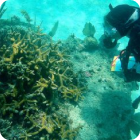
In 2014, an unidentified coral tissue loss disease was first observed in Miami-Dade County and quickly spread throughout the northern areas of the Florida Reef Tract (FRT). The disease outbreak continued to slowly and persistently progress south of Miami through the Upper and Middle Keys, reaching the Lower Keys by April 2018. Multiple factors make this disease outbreak an unprecedented event; primarily the number of coral species confirmed with lesions. Lesions have been reported on more than 25 species of the ~45 stony coral species in Florida, and it is suspected that other coral species may be affected but are not being captured with current monitoring efforts.
 Once a coral is affected by this disease and begins to lose tissue, it is almost certain the entire colony will die within a matter of weeks or months. The rate of disease progression varies across species and even colonies within a species, but overall, there are no partial mortality survivors. This particular progression differs from previous disease outbreaks or major bleaching events where only part of a coral colony died but the surviving part could potentially regenerate tissue and recover.
Once a coral is affected by this disease and begins to lose tissue, it is almost certain the entire colony will die within a matter of weeks or months. The rate of disease progression varies across species and even colonies within a species, but overall, there are no partial mortality survivors. This particular progression differs from previous disease outbreaks or major bleaching events where only part of a coral colony died but the surviving part could potentially regenerate tissue and recover.
Researchers are still working to confirm the pathogen(s) and transport mechanisms, but indications are that it is a bacterial infection spread by water, and through direct contact with infected corals. Monitoring data from 2017 and 2018 show that many Florida corals have sustained between 50% – 90% reduction in abundance based on species-specific susceptibility to this outbreak, and the disease is still spreading. The disease margin is currently located in the Lower Keys area (i.e., ~5 km west of Looe Key), and is expected to continue moving southwest along the FRT as summer water temperatures increase.
The severity of this situation has prompted FWC and partners to make an unprecedented effort to preserve corals from reef areas ahead of the approaching outbreak, so that we are prepared for restoration once the disease has run its course. The FWC, National Marine Fisheries Service (NMFS), Florida Keys National Marine Sanctuary (FKNMS), and the Florida Department of Environmental Protection (FDEP) have assembled the Florida Coral Rescue Team (Rescue Team) and have begun development of a Florida Coral Rescue Plan to save what is left of Florida’s healthy coral stocks. This Rescue Plan has two primary goals: 1) to prevent ecological extinction along the FRT for the most susceptible species, and 2) to maintain as much genetic diversity as possible for ~25 priority species in preparation for restoration and future disturbances.
The stark reality is that if the Rescue Team cannot fully develop and execute the Rescue Plan within a very short time frame, one third of the coral species that are found in Florida will become ecologically extinct, leaving nothing more than a few relic corals dotting the FRT. Click here to support the work.












